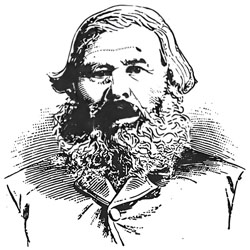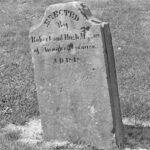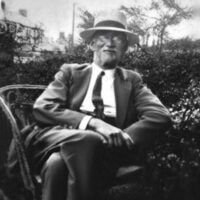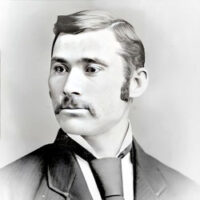Born on November 15th, 1819, in Ballygowan, Co. Down, Ireland, John Megraw’s early years were marked by the tumultuous events of his time. As a young farmer in Ireland, he witnessed the devastating effects of the potato famine, which ravaged the country from 1845 to 1852. The suffering and hardships endured by his fellow countrymen left a profound impact on him, motivating him to seek a better life. In 1846, amidst the challenges of the famine, John made a courageous decision that would shape his destiny: he married Isabella Wallace at the Ballygowan Presbyterian Church on February 17th. The ceremony, officiated by Rev. John Gamble and witnessed by James Gibson and Alexander McMorran, marked the beginning of a shared journey of love, resilience, and determination for the couple.
The Journey from Ireland to Canada West
In 1849, with the devastating effects of the potato famine still weighing heavily on Ireland, John and Isabella made a life-altering decision. Driven by their desire for a brighter future, they embarked on an arduous and potentially dangerous voyage to a foreign land then known as Canada West. Leaving behind their homeland, relatives, and friends, they set sail for the promise of new opportunities. This momentous journey marked the start of a new chapter in their lives, as they left behind the struggles of famine-stricken Ireland and set their sights on building a prosperous future in Canada.
After landing in Toronto, John, his wife, and two young children resided near Richmond on Yonge St. for a short period before he set out to locate a homestead in the untamed wilderness of the Queen’s Bush, an area in the Bruce Peninsula, Ontario, characterized by dense forests and promising opportunities for pioneering settlers. It was within this rugged and untamed landscape that John Megraw would forge a new path for himself and his family, carving out a homestead and leaving a lasting legacy in the heart of Canada’s wilderness.
Carving a Life in the Untamed Wilderness
In October 1851, accompanied by James Legge and his nephews, Moses and Aaron, John ventured through the untamed wilderness from Richmond Hill to Owen Sound, led by an Indian guide. From there, he continued along the Saugeen River, eventually arriving at the Gowanlock settlement, named after William Gowanlock, a Scottish immigrant who established a thriving farm in the area. Inspired by the remarkable progress made by the Gowanlock family, John found himself drawn to the town of Paisley, then known as Mud River, where the first pioneer settlers, Simon Orchard and Samuel T. Rowe, had arrived earlier that year.
John returned to Richmond Hill that winter, and in the following spring, he went back to Mud River, where he cleared a piece of land and planted potatoes. Tragically, a devastating fire destroyed his shanty, prompting him to strike a deal with John Valentine, who was traveling down the river at the time. Mr. Valentine was putting up a grist mill on the Tees River, and he agreed to hire John. So he sold the rights and improvements of his cleared land to Archie Pollock and his potatoes to Timothy Craig and went to work for Mr. Valentine.
Subsequently, John acquired the property where the Paisley station stands today, securing it in 1852. On October 11th of that year, he erected a shanty on the exact spot where the former Grand Trunk Railroad ticket office once stood. In January 1853, the family moved into this new dwelling. The following year, they settled on a farm located at Lot 1, Concession 22 in Greenock, which became their beloved homestead.
Building a Strong Family Foundation
John and Isabella Megraw were blessed with a large family, and their children became a testament to their enduring love and dedication. Their children were:
i. Robert John Megraw (b.1846)
ii. Hugh Megraw (b.1851)
iii. Grace Megraw (b. ca.1852)
iv. Elizabeth Megraw (b.1853)
v. James Alexander Megraw (b. ca.1856)
vi. Ainsley Megraw (b.1857)
vii. Martha Ann Megraw (b.1859)
viii. Agnes Jane Megraw (b.1862)
ix. Wallace Megraw (b.1865)
x. Hugh Megraw (b.1866)
xi. Isabella Megraw (b. ca.1868)
xii. Sara Megraw (b. 1870)
John’s commitment to his family was unwavering, and he raised his children with the values of hard work, perseverance, and resilience. They, in their own unique ways, contributed to their community and carried on the Megraw legacy. As the years passed, the Megraw family grew and spread their roots across different parts of Canada, leaving an enduring mark on the nation’s history.
A Lifelong Dedication to Masonic Values
John took an active but ostentatious interest in public affairs, being all his life a supporter of the Liberal-Conservative cause. In religion, he was of the Presbyterian faith. But the organization that claimed his longest fealty was the Masonic Order, and he was perhaps one of the oldest Masons in Canada. He was initiated in Lodge No. 136 Ballygowan, Ireland, during the 1840s, and was a charter member of Aldworth Lodge, Paisley. Before leaving Ireland, John had advanced into the higher orders of masonry, and in his dealings with his fellow man, the almost child-like faith in masonry in which he evinced, and the manner in which it dominated his life, showed that masonry was with him a vital principle of conduct and action.
A Life Remembered and a Legacy Preserved
Always of a rugged constitution, John enjoyed good health throughout his life. Four years before his death, he met with an accident resulting in a fracture of a hip joint, which, although crippling him for his remaining years, did not impair his general health. To those of his family who had not seen him for years, it seemed difficult to think of him ailing.
On March 14th, with deep sadness but profound respect, John’s remains were buried in the Paisley cemetery with Masonic honors. The Masonic Order, an organization that held immense significance in his life, honored him with a burial ceremony befitting his lifelong commitment. The afternoon of March 14th became a solemn occasion as family, friends, and members of the Masonic Order gathered to pay their final respects to John Megraw, the pioneer, the family man, and the steadfast Mason whose life touched so many.
With his passing, John Megraw leaves behind a proud lineage and a family tree that branches out to numerous descendants, each of whom can trace their roots back to this courageous pioneer. His unwavering faith, dedication to his family and community, and his enduring legacy continue to resonate through generations, serving as a testament to his character and the lasting impact he made. Although his surname may not be carried by his descendants today, the spirit of John Megraw lives on, inspiring future generations to embody the same values of resilience, determination, and love for family.




